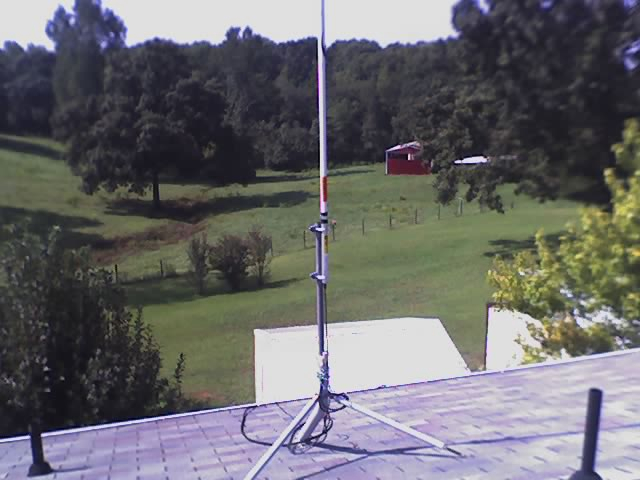Also give me your feeling on this idea I have for the Antenna mounting.
Up on the roof now I have a tripod that currently holds an unused Satellite Internet dish. It was put up there about a year or so back. These dishes are fairly large (perhaps about three times the size of a normal satellite TV service one) and so the tripod is quite stout. In fact, from looking at some available tripods that are purpose built for verticles I find its a good deal heavier and larger (and nicer) than most I am finding. Plus its already there. And its already grounded to its own Ground rod line and all there already.
My plan is to remove the dish from the tripod (since it's no longer needed, anyone want a nice working Starband set up?) and mount the Antron 99 to that tripod. The upright pipe from that tripod is a bit larger diameter than typicial antenna pole stuff. But I have a nice new piece of TV antenna rod about 5-6 feet long. And I would estimate that the tripod stands about 2-3 feet off the roof surface as it is. So I was going to clamp (actually dril and bolt through several times) this extra length of smaller diameter pole into the tripod neck and then mount the A99 to that small pole a bit higher up. So it would be about 7 feet off the deck and perhaps 3 feet about the roofs peak where the bottom of the A99 would start. And then of course it goes up 18 more feet from there.
Now the roof is two story at the back and one story to the front of the house. So overall height of the antenna is hard to calculate. It would be at least 30 feet to the bottom measured from the back yard. But perhaps only 20 or so feet measured from the ground up from the front yard perspective. Best I can do I think.
Then my clever scheme is to put one of these lightning arrestors (pictured below) on but I am not sure where. I would assume at the junction of the Antenna to the Coax running down to the house and bridge the Ground to it?

then this will go on down to the shop and into the shop and be attached to a one into two antenna switch. Then the radio and scanner hooked to that switch... and so on...
So its like this:
A99 - grounded pole - tripod - Lightning arrestor - coax - switch - scanner (on switch position 2) antenna tuner/meters/radio (on switch position 1)
What say you?
Up on the roof now I have a tripod that currently holds an unused Satellite Internet dish. It was put up there about a year or so back. These dishes are fairly large (perhaps about three times the size of a normal satellite TV service one) and so the tripod is quite stout. In fact, from looking at some available tripods that are purpose built for verticles I find its a good deal heavier and larger (and nicer) than most I am finding. Plus its already there. And its already grounded to its own Ground rod line and all there already.
My plan is to remove the dish from the tripod (since it's no longer needed, anyone want a nice working Starband set up?) and mount the Antron 99 to that tripod. The upright pipe from that tripod is a bit larger diameter than typicial antenna pole stuff. But I have a nice new piece of TV antenna rod about 5-6 feet long. And I would estimate that the tripod stands about 2-3 feet off the roof surface as it is. So I was going to clamp (actually dril and bolt through several times) this extra length of smaller diameter pole into the tripod neck and then mount the A99 to that small pole a bit higher up. So it would be about 7 feet off the deck and perhaps 3 feet about the roofs peak where the bottom of the A99 would start. And then of course it goes up 18 more feet from there.
Now the roof is two story at the back and one story to the front of the house. So overall height of the antenna is hard to calculate. It would be at least 30 feet to the bottom measured from the back yard. But perhaps only 20 or so feet measured from the ground up from the front yard perspective. Best I can do I think.
Then my clever scheme is to put one of these lightning arrestors (pictured below) on but I am not sure where. I would assume at the junction of the Antenna to the Coax running down to the house and bridge the Ground to it?
then this will go on down to the shop and into the shop and be attached to a one into two antenna switch. Then the radio and scanner hooked to that switch... and so on...
So its like this:
A99 - grounded pole - tripod - Lightning arrestor - coax - switch - scanner (on switch position 2) antenna tuner/meters/radio (on switch position 1)
What say you?

